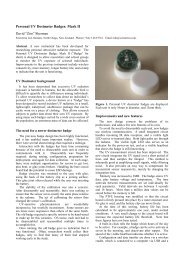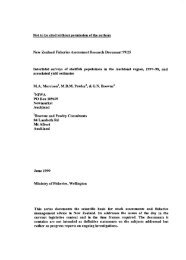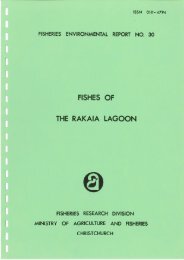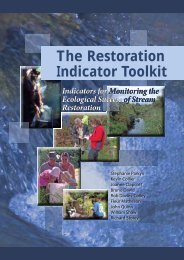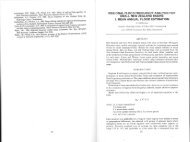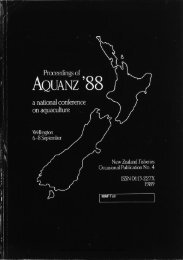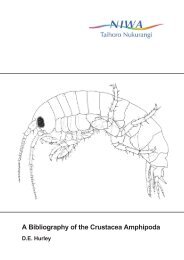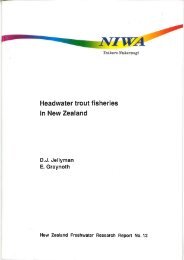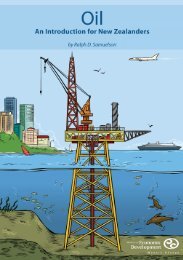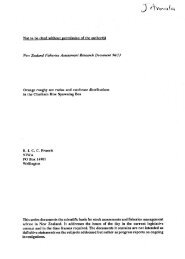WATER & SOIL - These are not the droids you are looking for.
WATER & SOIL - These are not the droids you are looking for.
WATER & SOIL - These are not the droids you are looking for.
Create successful ePaper yourself
Turn your PDF publications into a flip-book with our unique Google optimized e-Paper software.
allowing curves ra<strong>the</strong>r than just straight lines to be fitted to<br />
<strong>the</strong> regional data with confidence. In this New Zealand<br />
curve and <strong>the</strong> eastern curve is <strong>the</strong> straight-line EVl. This is<br />
d generalised curves<br />
ynn (1978) <strong>for</strong> Creat<br />
given in Figure 3.26.<br />
curve and <strong>the</strong> corresponding regional ones, results from in_<br />
clusion in <strong>the</strong> development of <strong>the</strong> generalised curve of some<br />
of <strong>the</strong> extreme flood peaks which had been excluded from<br />
<strong>the</strong> derivation of <strong>the</strong> corresponding regional curves. While<br />
<strong>the</strong>re is a valid argument <strong>for</strong> <strong>the</strong> inclusion of <strong>the</strong>se extreme<br />
e still been too<br />
<strong>the</strong>reby weightperiods.<br />
been described<br />
New Zeatand curves bear a remarkabl|t','"tJJr:i*t;tÏ::<br />
to <strong>the</strong>ir Great Britain counterparts.<br />
Although <strong>the</strong> two countries have broadly similar cli_<br />
mates, New Zealand has greater extremes of wet and dry.<br />
That <strong>the</strong> New Zealand curves do <strong>not</strong> reflect this with túe<br />
western and eastern curves be<br />
-<br />
tively, in relation to <strong>the</strong> corre<br />
- is possibly due to <strong>the</strong> ave<br />
ment of <strong>the</strong> curves, i.e., <strong>the</strong> i<br />
treme wet or dry climates is largely nullified by <strong>the</strong> lumping<br />
toge<strong>the</strong>r of <strong>the</strong>se <strong>are</strong>as with o<strong>the</strong>rs which <strong>are</strong> <strong>not</strong>iceãblt<br />
drier or wetter, respectively. The fact that <strong>the</strong> western New<br />
was used to describe <strong>the</strong> generalised curve.<br />
ntinuity between<br />
Oing generalised<br />
"<br />
. ;;,f.tïi'l"i::;<br />
expectation. This may be viewed as taking a weighted aver_<br />
age of <strong>the</strong> estimates.<br />
3.5.3 Vadation within a reg¡on<br />
3.5.2 Compar¡son with rhe Br¡t¡sh lsles<br />
;<br />
f<br />
<strong>the</strong>se curves reveals some remarkable similarities with <strong>the</strong><br />
curves obtained in this New Zealand study.<br />
First of all, <strong>the</strong> British Isles regional curves display <strong>the</strong><br />
same trend of an increase in <strong>the</strong> slope of <strong>the</strong> curves between<br />
those <strong>for</strong> <strong>the</strong> western regions and those <strong>for</strong> <strong>the</strong> eastern re_<br />
gions <strong>the</strong> curve <strong>for</strong> <strong>the</strong> western-most<br />
- region, <strong>the</strong> whole of<br />
Ireland, has <strong>the</strong> smallest slope, whereas <strong>the</strong> curve <strong>for</strong> <strong>the</strong><br />
eastern-most region, East Anglia, has <strong>the</strong> greatest,<br />
Fur<strong>the</strong>r, <strong>the</strong> range of <strong>the</strong> ordinates of <strong>the</strong> British Isles<br />
and New Zealand curves is almost <strong>the</strong> same at high return<br />
periods. For example, <strong>the</strong> South Island West Coast regional<br />
curve, which has <strong>the</strong> smallest slope of all <strong>the</strong> New Zéaland<br />
very dry in relation to<br />
is likely to be steeper<br />
catchment which is ve<br />
tend to have a flatter<br />
An extension of this argument leads to <strong>the</strong> concept of<br />
sub-regions which, although geographically part of a làrger<br />
surrounding region, display a e/Q frequency trend of thiir<br />
is<br />
E<br />
b<br />
50<br />
3.5.4 Secular climatic variat¡on<br />
-In th9 regionalisation procedure described by Dalrymple<br />
(19@), it is recommended that all <strong>the</strong> flood records should<br />
be brought to a common base length by correlating <strong>the</strong> re-<br />
Water & soil technical publication no. 20 (1982)



